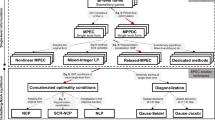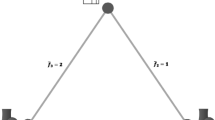Abstract
Over the last two decades, the electricity industry has shifted from regulation of monopolistic and centralized utilities towards deregulation and promoted competition. With increased competition in electric power markets, system operators are recognizing their pivotal role in ensuring the efficient operation of the electric grid and the maximization of social welfare. In this article, we propose a hypothetical new market of dynamic spatial network equilibrium among consumers, system operators and electricity generators as solution of a dynamic Stackelberg game. In that game, generators form an oligopoly and act as Cournot-Nash competitors who non-cooperatively maximize their own profits. The market monitor attempts to increase social welfare by intelligently employing equilibrium congestion pricing anticipating the actions of generators. The market monitor influences the generators by charging network access fees that influence power flows towards a perfectly competitive scenario. Our approach anticipates uncompetitive behavior and minimizes the impacts upon society. The resulting game is modeled as a Mathematical Program with Equilibrium Constraints (MPEC). We present an illustrative example as well as a stylized 15-node network of the Western European electric grid.









Similar content being viewed by others
Notes
Note, we distinguish congestion rent from the term “No congestion” describing the scenario.
References
Blumsack S, Perekhodtsev D, Lave LB (2002) Market power in deregulated wholesale electricity markets: issues in measurement and the cost of mitigation. Electr J 15(9):11–24
Czyzyk J, Mesnier M, Mor J (1998) The NEOS server. IEEE Journal on Computational Science and Engineering 4(3):68–75
Daxhalet O, Smeers Y (2001) Variational inequality models of restructured electric systems. In: Ferris MC, Mangasarian OL, Pang JS (eds) Applications and algorithms of complementarity. Kluwer Academic Press, Dordrecht
Day C, Hobbs BF, Pang JS (2002) Oligopolistic competition in power networks: a conjectured supply function approach. IEEE Trans Power Syst 17:597–607
Dockner E, Jorgensen S, Long NV, Sorgen G (2000) Differential games in economics and management science. Cambridge University Press, Cambridge MA
Friesz TL (2010) Dynamic optimization and differential games. Springer, New York
Gabriel SA, Leuthold FU (2010) Solving discretely-constrained MPEC problems with applications in electric power markets. Energy Econ 32(1):3–14
Gabriel S, Conejo AJ, Fuller JD, Hobbs BF, Ruiz C (2013) Complementarity modeling in energy markets. Springer, New York
Güler T, Gross G (2005) A framework for electricity market monitoring, the University of Illinois at Urbana-Champaign, NSF ECS-0224829
Hobbs BF (2001) Linear complementarity models of Nash-Cournot competition in bilateral and POOLCO power markets. IEEE Trans Power Syst 16(2):194–202
Hobbs BF, Helman EU (2004) Complementarity-based equilibrium modeling for electric power markets. In: Bunn DW (ed) Modeling Prices in Competitive Electricity Markets, Wiley, Chichester, West Sussex, England
Hobbs BF, Metzler CB, Pang JS (2000) Strategic gaming analysis for electric power systems: an MPEC approach. Power 1(2):638–645
Isaacs R (1999) Differential games: a mathematical theory with applications to warfare and pursuit, control and optimization dover publications. Mineloa, New York
Mehlmann A (1988) Applied differential games. Plenum Press, New York
Meier AV (2006) Electric power systems: a conceptual introduction. Wiley, Hoboken
Momoh JA (2009) Electric power system applications of optimization. CRC Press, Boca Raton
Mookherjee R, Hobbs BF, Friesz TL, Rigdon MA (2010) Dynamic oligopolistic competition in an electric power network and impacts of infrastructure disruptions. In: Momoh J, Mili L (eds) Economic market design and planning for electric power systems, pp 87–111
Murphy FH, Smeers Y (2005) Generation capacity expansion in imperfectly competitive restructured electricity markets. Oper Res 53(4):646–661
Nanduri V, Das TK (2009) A survey of critical research areas in the energy segment of restructured electric power markets. Int J Electr Power Energy Syst 31 (5):181–191
Nash J (1951) Non-cooperative game. The Annual of Mathematics 54(2):286–295
Neuhoff K, Barquin J, Boots MG, Ehrenmann A, Hobbs BF, Rijkers FAM, Vázquez M (2005) Network-constrained Cournot models of liberalized electricity markets: the devil is in the details. Energy Econ 27(3):495–525
Rahimi AF, Sheffrin AY (2003) Effective market monitoring in deregulated electricity markets. IEEE Trans Power Syst 18(2):486–493
Rivier M, Ventosa M, Ramos A, Martínez-Córcoles F, Toscano Á C (2001) A generation operation planning model in deregulated electricity markets based on the complementarity problem. In: Ferris MC, Mangasarian OL, Pang JS (eds) Complementarity: applications algorithms and extensions. Kluwer Academic Publishers, Dordrecht
Schweppe FC, Caramanis MC, Tabors RE, Bohn RE (1988) Spot pricing of electricity. Kluwer Academic Publishers, Norwell
Stackelberg VH (1952) The theory of market economy. Oxford University Press, Oxford
Varian HR (2006) Intermediate microeconomics: a modern approach, 3rd edn. W.W. Norton and Company, New York
Ventosa M, Denis R, Redondo C (2002) Expansion planning in electricity markets. Two different approaches
Ventosa M, Ballo I, Ramos A, Rivier M (2005) Electricity market modeling trends. Energy Policy 33(7):897–913
VonNeumann J, Morgenstern O (1944) Theory of games and economic behavior. Princeton University Press, Princeton
Wei JY, Smeers Y (1999) Spatial oligopolistic electricity models with Cournot generators and regulated transmission prices. Oper Res 47(1):102–112
Wood AJ, Wollenberg BF (2001) Power generation operation and control, 2nd edn. Wiley, New York
Wu F, Varaiya P, Spiller P, Oren S (1996) Folk theorems of transmission access: proofs and counterexamples. J Regul Econ 10:5–23
Yao J, Adler A, Oren SS (2008) Modeling and computing two-settlement oligopolistic equilibrium in a congested electricity network. Oper Res 56(1):34–47
Acknowledgments
The authors would like to sincerely thank the two anonymous reviewers for their helpful comments and suggestions. This material is based upon work supported by the National Science Foundation under Grant No. DGE1255832. Any opinions, findings, and conclusions or recommendations expressed in this material are those of the author(s) and do not necessarily reflect the views of the National Science Foundation.
Author information
Authors and Affiliations
Corresponding author
Rights and permissions
About this article
Cite this article
Neto, P.A., Friesz, T.L. & Han, K. Electric Power Network Oligopoly as a Dynamic Stackelberg Game. Netw Spat Econ 16, 1211–1241 (2016). https://doi.org/10.1007/s11067-016-9337-7
Published:
Issue Date:
DOI: https://doi.org/10.1007/s11067-016-9337-7




